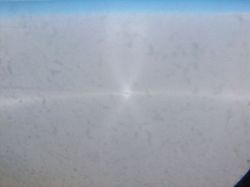
Subparhelic circle
Encyclopedia

Halo (optical phenomenon)
A halo from Greek ἅλως; also known as a nimbus, icebow or gloriole) is an optical phenomenon produced by ice crystals creating colored or white arcs and spots in the sky. Many are near the sun or moon but others are elsewhere and even in the opposite part of the sky...
, an optical phenomenon
Optical phenomenon
An optical phenomenon is any observable event that results from the interaction of light and matter. See also list of optical topics and optics. A mirage is an example of an optical phenomenon....
located below the horizon
Horizon
The horizon is the apparent line that separates earth from sky, the line that divides all visible directions into two categories: those that intersect the Earth's surface, and those that do not. At many locations, the true horizon is obscured by trees, buildings, mountains, etc., and the resulting...
. It passes through both the subsun
Subsun
A subsun or sub-sun is a glowing spot seen within clouds when the clouds are observed from above. The subsun appears directly below the sun, as if it were caused by sunlight reflecting from a body of water. The reflection is caused by large numbers of flat ice crystals...
, below the sun
Sun
The Sun is the star at the center of the Solar System. It is almost perfectly spherical and consists of hot plasma interwoven with magnetic fields...
, and the antisolar point
Antisolar point
The antisolar point is the imaginary point on the celestial sphere exactly opposite the Sun. It is where anticrepuscular rays appear to converge, and on a moonless night away from city lights, it is often possible to see the gegenschein there. The apex of a rainbow will also form roughly 42...
, opposite to the sun. The subparhelic circle is the subhorizon counterpart to the parhelic circle
Parhelic circle
A parhelic circle is a halo, an optical phenomenon appearing as a horizontal white line on the same altitude as the sun, or occasionally the Moon. If complete, it stretches all around the sky, but more commonly it only appears in sections....
located above the horizon.
Located on the subparhelic circle are several relatively rare optical phenomena: The subsun
Subsun
A subsun or sub-sun is a glowing spot seen within clouds when the clouds are observed from above. The subsun appears directly below the sun, as if it were caused by sunlight reflecting from a body of water. The reflection is caused by large numbers of flat ice crystals...
, the subparhelia, the 120° subparhelia, Liljequist subparhelia, the diffuse arcs, and the Parry antisolar arcs.
On the accompanying photo centred on the antisolar point
Antisolar point
The antisolar point is the imaginary point on the celestial sphere exactly opposite the Sun. It is where anticrepuscular rays appear to converge, and on a moonless night away from city lights, it is often possible to see the gegenschein there. The apex of a rainbow will also form roughly 42...
, the subparhelic circle is viewable as a gently curved horizontal line intercepted by anthelic arcs.

